It was dreamy to sleep with our windows open. Our room featured six windows, and they all opened. Each window had two panes of glass, and both opened with the same detachable handle. (Thousands of hotels in NYC do not have windows that can be opened). We only needed to open one tall window to let in a cooling breeze. Nordic air is some of the cleanest in the world (as is the water, which we safely drank from the tap). Lewis and I enjoy urban European locations because they are much quieter (civilized) at night than New York City. To hear samples of our existence in NYC, please click this link:
https://halfwindsorfullthrottle.blogspot.com/2021/11/local-noise-pollution.html
Therefore, we loved the chance to sleep with the windows open in Finland! It was immeasurably refreshing. Except for one garbage truck--and only for 30 minutes--all of our nights were serene. We didn't get cold either. Despite being further north than NYC, Helsinki wasn't colder; the air temperature was surprisingly mild. We awoke fully revitalized.
Showering in the spacious bathroom was very pleasant. We also noticed an unusual item: a hose attached to the wall, betwixt the sink and toilet (seen below). It had a hand-activated nozzle.
I suspected that it could be used like a bidet (which we enjoyed throughout our visits to Japan and Italy). The Front Desk personnel explained that it could also be used to rinse the sink or floor (there was a drain on the floor under the sink). All Finnish lavatories have that type of hose... which implies a clean society.
Upholding a Nordic custom, the hotel's restaurant offered a daily breakfast smorgasbord. The buffet consisted of beverages, porridge, fruit, eggs, sausages, and pastries.
However, we preferred to diversify our eating experiences at other places. Our hotel's prime location in the Kamppi District meant that we were central to everything. Its name derives from the Swedish word for "battle"; ironically, when Russia ruled the land, its military camps were there. Adjacency to Bulevardi meant that we could access that historic street easily.
On the Boulevard, we entered Ekberg Bakeshop. It is the oldest bakery in the city--founded in 1852.
Side-by-side, it has another shop where you can buy prepared foods and baked goods "to go".
For the full experience, we opted for the eat-in bakeshop. Luckily, we entered before a line of customers formed outside. Perfect timing!
Bright-eyed waitresses sat us at a deuce in the center of the room. Most people paid for the breakfast buffet: scrambled eggs, viennoiserie, and fruits. Finns are frugal, and there is nothing wrong with that.
Lewis and I were more eager to try their pastries and freshly-squeezed orange juice (we saw a waitress make it). I ordered a latte... but the one at Robert's was better.
We are partial to Princess Cakes, which are named for a princess in Sweden. So, when we saw them in the display case, we immediately ordered one.
In celebration of Halloween, its normal green marzipan coating was colored black, as seen below.
We shared a slice of a Budapest Roll, which was invented by a Swedish chef in the 1950s: citrus, hazelnuts, meringue, vanilla cream filling, and dark chocolate. Lewis ordered an open-faced shrimp sandwich, which was loaded with North Sea crustaceans on a dollop of mayonnaise atop dense rye bread. Our total was €47.30.
From there, we earnestly began a day of browsing/shopping. From the bakeshop, we rode the #6 tram and exited at the retail district on Mannerheimintie, a boulevard named for a former president, Baron Carl Gustaf Mannerheim. (The Parliament House is further north on the street).
There are a few things you must realize about the people in Finland. They maintain a Life/Work balance. That is why many shops and restaurants are closed on Sunday... and some are also closed--or have shortened hours--on Monday. Many hotel restaurants and bars are closed on Sunday--regardless of how many guests are in the hotels. Nothing interferes with the Finnish society's Day Off. (Our hotel's eateries were closed on Sunday, and when we went to a bar in a nearby hotel, it was also closed).
Another thing to bear in mind is that a "happy society" does not "buy things" as often as overcommercialized nations. Statistically, people who are unhappy at their core tend to purchase many things, in an effort to make themselves feel better. Content people are not "shopaholics" addicted to consumerism or overconsumption. Since Finland is recognized as the Happiest Place on Earth, it makes sense that its retail segment is not extravagant. Do not expect to find a plethora of clothing/accessories brands in Helsinki. The same brands are sold in every shopping center and department store--regardless of their proximity to each other. Surely, Finns follow trends and buy fashionable attire... but they are content with 24 brands, instead of 350 (the same logic applies to how many television channels there are). We hoped to find Finnish brands or European ones that were new to us, but many of the brands are American with mid-level prices.
Do not expect to find an abundance of luxury boutiques in Finland. Having missed availability in London to buy an item from Fendi, Lewis sought a boutique in Helsinki, but Fendi does not operate a store in Finland. Neither does Chanel. We located a store called Luxbag For Men that showcased a marginal smattering of top-tier brands, but only one of each. The bearded salesman was friendly, but it seems like he spends a lot of time alone in his trendy shop.
One of the few stand-alone luxury boutiques belonged to LVMH... and they were happy to collect all the shoppers who had few alternatives. Luxury stores were full of Chinese and Russian clients. Assuredly, some Finns splurge on indulgent fashion items, but most are sensibly frugal. Lewis and I agree that having simpler clothes/accessories causes less to worry about maintaining them. Not caring if you accidentally scuff a shoe on a cobblestone--or accidentally scuff your handbag on a bicycle--keeps you happier. Simple = elegant. Similarly, Finns are not braggarts or showoffs. (The tallest building in Finland is 35 floors). Impervious to advertising campaigns, they will not go into debt to purchase a flashy new item of inconsequential value. (Having witnessed NYC Automobile Shows, NYC Fashion Weeks, Kitchen Expos, and Home Expos, Lewis and I appreciate that rationale to avoid outrageously overpriced things. We invest in certain things, but do not follow trends irresponsibly). Understanding those values will let you appreciate Finnish culture.
Next, we went to the Kluuvi neighborhood and strode into Stockmann Department Store. Housed in a large Art Moderne building, it has been a retail icon for decades.
To our worldly perceptions, its layout and assortment was equivalent to Bloomingdale's in the USA. We never experienced "pressure to buy" from a sales associate, and they never pouted if we left without making a purchase. (We notice that nearly everywhere outside of the USA, and it's nice).
Taking the Art Deco elevator down to the lowest level...
...we used Helsinki's tunnels to cross underneath the street to another shopping site.
Helsinki has a dozen underground walkways; several connect the largest shopping centers. In other areas are an Olympic-size swimming pool and a go-cart race track. We emerged from the tunnel at Forum Shopping Center: an amalgamation of buildings that consumes an entire block.
In Helsinki, you can also avoid traffic by using the car-free pedestrian-only shopping alleys.
We were delighted to find a shop selling handmade Christmas ornaments! We bought two hand-painted wooden ones, and we got two handcrafted ornaments for our friends.
Below, notice the bilingual sign. Relatedly, half of the time, there were no salespeople watching the customers. Clearly, that is a trusting society!
I browsed through a shop that sold hand-knitted wool sweaters. I liked the ones from Norway that featured a Fair-Isle style. I wanted to get a cardigan with pewter closures, but the steep price was €350, so I declined because I can buy it online directly from the Norwegian website for $240.
*In truth, I bought it during our trip to Norway, two years later. To see that amazing adventure, please use this link: https://halfwindsorfullthrottle.blogspot.com/2023/08/our-trip-to-oslo-norway-karl-johan.html
Similar to the Christmas Shop, this one had only one salesman... and he didn't guard the open doorway. He seemed unconcerned of shoplifters who might "grab and run"... which occurs daily in New York. Perhaps, show owners are confident of their police and "street cameras" to capture thieves. That is the opposite of the boutique where Lewis works in SoHo, where a dozen robbers were never caught by NYC's overpaid-yet-uncaring police who merely respond to crimes but don't solve them.
Afterwards, we meandered through the rest of Forum, but it was uneventful.
Here is something else to know about Finland: signage is not excellent. The positions of certain signs cause them to be misleading, some don't properly inform people, some are too small for their purposes, and sometimes there are no signs when you need them. For example, from within courtyards at Forum, there are huge signs saying "FORUM" on doorways... that only lead you to exits--instead of to more shopping areas. Dead-ends and a lack of Floor Directories (anywhere beyond staircases) caused us to wander aimlessly. *(I'll mention it several more times, as I continue to describe our activities).
Forum was similar to Stockmann... and they were similar to Kamp Galleria, as well as Sokos Shopping Center. Approaching Sokos, we observed a large awning for the Sokos Hotel.
It is a shared entrance for both businesses, but you might never realize it. Upon entering, you only see the lobby... which exudes a classy Nordic sleekness.
We looked around but there were no signs indicating access to the mall. After we crossed the lobby, I saw a small sign that directed visitors around a wall and up a few steps to a glass door. The door looked as if it might lead to a washroom.
Entering that modest-size door puts you inside the vast shopping area.
We saw the same brands that existed at Stockmann and Forum, so we departed... and then discovered the entrance--unobtrusively on the furthest corner of the building, away from the main streets.
*To learn about retail in the USA, please use this link:
https://halfwindsorfullthrottle.blogspot.com/2017/12/why-brick-and-mortar-stores-fail-and.html
Thankfully, LVMH had the item that Lewis desired. Despite plenty of salespeople on duty, the boutique was so busy that customers waited 30 minutes before receiving service. Yet, the staff was wholly pleasant. Other retailers are full of dead-faced workers who seem to dread their pressured jobs. But, Finland is full of bright-eyed (we sensed smiles behind their face masks) professionals. Lewis loved his purchase; he was lucky to get the last one in the country! It cost less in Finland than in the USA.
Happy with his purchase, Lewis strolled with me along the Esplanadi. It is Helsinki's version of P.C. Hooftstraat (in Amsterdam) or Bond Street (in London). It runs parallel to a long park.
Turning a cobbled corner, we faced the majestic Helsinki Cathedral, circa 1852.
It is the highest part of the Kruununhaka neighborhood, which is the oldest in the city. It is the crowning glory of Senate Square, overlooking the Parliamentary Palace (seen below)...
Founded in 1550, Helsinki was moved to its current location in 1640. But it was not originally the capital. The City of Turku was the nation's capital until 1812, when the Russian Emperor, Alexander the Great, made Helsinki the capital. He chose it because it was further from Sweden's influence and closer to Russia.
Looking at my photo of the cathedral, you might expect the entrance to face the square. There are no signs to tell you otherwise.
So, we climbed the stairs and tried to enter, but the doors were locked. There was no sign to explain where the entrance was; visitors are expected to figure it out. We saw a tourist try the doors on the right-side, but he returned unsuccessful. We followed other visitors to the left-side of the cathedral, and that's where the entrance is. Inside, the space seemed austere. Incongruently, the pulpit and pipe organ are grandly decorated with baroque flourishes, and ornate chandeliers hang low over the pews. But the rest of the vast space is barren.
The tall dome--and its windows--are unappreciated because the ceiling blocks its full height. (The last time that we were crestfallen from a cathedral was in Barcelona: the Basilica de la Sagrada Familia of 1882 has unorthodox architecture and suffers from perpetual construction). Looking around, we wondered if a religious reformation stripped the nave of its adornments, as happened in the Netherlands? We did value the sight of a bible, hand-scribed in the 1450s.
Enjoy Lewis' video of the view of Senate Square, built in 1812.
Tracing some tram rails on Alexander Street, we encountered a historic building named Sederholm House from 1757.
For history fans like us, such a pretty discovery was lovely. NYC ripped down nearly all of its historic structures from the 1700s and early 1800s, due to its greed for overdevelopment. The historic area of our overpopulated neighborhood has only 24 wooden houses (dating from the 1820s to 1880s), but due to a lack of preservation in NYC, another one was demolished during the week before this trip. Therefore, Lewis and I cherish the site of a successfully preserved historic building elsewhere.
Next to it was the City of Helsinki Museum. While there, we tried to register for a Halloween Walking Tour that their website mentioned. But, the employees could not find that event on the updated calendar and assumed that it had been cancelled.
Dejected, we headed down the street and noticed the Ritarihuone (House of Nobility, a.k.a. Knight's Room), which is a neo-Gothic redbrick building. The word reminded us of the Ridderzaal, which is the Hall of Knights in the Netherlands.
Knighthoods and nobility were introduced by Sweden to Finland in 1280. Those groups lost governmental influence in 1906. The remaining nobility consists of counts, barons, hereditary knights (like English baronets), and untitled nobles. 4,000 people of 145 families are noble, but many are untitled.
Nearby, we observed the Prime Minister's Palace. Painted yellow, it is next to the City Hall, and both overlook the harbor. Built in 1816 as a merchant's mansion, it was bought by the government in 1837 and remains one of three presidential residences.
Having recently come from England, we expected the governmental capital to possess regiments of guards/sentries patrolling the properties. Helsinki is more modest; two sentries occupied guardhouses. Their uniforms reminded me of the German Army.
*To see when we watched the start of the Changing of the Guard ceremony in London, please use this link:
https://halfwindsorfullthrottle.blogspot.com/2022/09/our-return-to-london-uk-part-2-of-6.html
Alongside the palace is the blue-painted Garrison (built in 1840) for the Guard Jaeger Regiment of the Finnish Army.
It provides the presidential guards. A single sentry stood outside a guard-hut--looking properly uniformed, with an upturned face against the chilly breeze.
The soldiers seemed pleasant.
Across a canal, we spotted the Uspenski Cathedral (Russian Orthodox), atop a rocky hill. Erected in 1862 (using reclaimed bricks from a demolished fortress), it is famous for an ornate exterior and interior. We decided to visit it.
On our way, a large sign for a Holiday Market drew us closer... but the indoor space was vacant (somebody forgot to remove the sign, or it was extremely premature). But the rest of the area was picturesque. Historic redbrick warehouses were converted into restaurants and waterfront offices. The whole island is the Katajanokka neighborhood.
We climbed the stairs of the hill. There were no signs to warn us that the site was closed for construction. Other tourists descended, but their foreign languages prevented us from understanding. We got to the top of the hill and tried to enter the lower doors. They were locked. So, we went around and up the main stairs. When we finally reached the doorknobs, we saw yellow tape holding them shut. That's how visitors were expected to realize that the building was closed for construction.
If you get inside, the interior looks like this...
Dismayed, we retraced our steps and crossed a pedestrian bridge to the Kaartinkaupunki neighborhood. We visited the Market Square, which many websites promoted as the largest in the capital.
However, none of them mentioned that the market is a fraction of its usual size after September. In fact, several things are marginalized after September: access to island-parks, outdoor markets, walking tours, and the city's amusement park is closed (unlike Copenhagen's). There were only six tents, Yet, those purveyors cheerily offered hand-hewn wooden mugs, hand-whittled wooden spoons, crocheted scarves, knitted mittens, and colorful trivets. (Had someone sold a tea-cozy made out of colorful yarn, we would've bought it). Three other tents sold "street food": herring, fried fish & chips, and salmon soup--which is quite popular.
An indoor Food Market was also there. Constructed in 1889, its stalls were full of smoked fish, freshly-butchered meats, artisanal chocolates, dried herbs, teashops, a sunny cafe, and souvenir shops.
We walked across a footbridge to reach the city's sightseeing Ferris-wheel. It was Lewis' first time on one! Since Helsinki is a coastal city, we knew it would provide nice views of the water. However, getting there was tricky. First, we saw a building with a ticket booth. Despite its sign that showed the Ferris-wheel, it only sold tickets to an IMAX video.
On the other side of the parking lot, we saw a wood building with three ticket windows, so we assumed it was for the Ferris-wheel. (The orange sign in the image below wasn't attached to the building at the time).
Only as we got closer could we realized that the ticket windows were unused. There was no sign above the door, but when we entered the lobby, we realized that it was for a public sauna. Saunas are hugely popular in Finland. For centuries until the 1750s, most Europeans rarely bathed, but Nordic people bathed weekly--thanks to their popular saunas.
Allas Sauna & Sea Pool features two outdoor swimming pools, one swimming area in the harbor's water, an indoor cafe, a rooftop cafe, and many sauna rooms. Helsinkians use it day and night, and this is its mantra...
(Currently, Lewis and I live on a boulevard that is alongside a river, so we enjoy waterside views every day. It is rejuvenating. Yet, NYC has no cafés on that riverfront, which is absurd, and the water pollution is unfixed for 100+ years, so there are no saunas or swimming areas).
The queue of customers was long, so we didn't wait to ask for directions. We simply exited and walked towards the towering Ferris-wheel. Unexpectedly, we encountered a shirtless man exiting the changing rooms (which are unattached to the sauna facility), and his towel-covered swagger was nice to admire.
After the row of changing rooms...
...we arrived at the tall Ferris-wheel, but a fence blocked us.
There wasn't a sign, but I detected the dark handle of a gate in the middle of the fence--out in the middle of the lawn. It gave access to the Ferris-wheel. Hooray!
The cheeriest man possible welcomed us into our compartment. It seemed that we had the entire wheel to ourselves. Temperature controls, music volume, and an intercom were accessible on the ceiling of our compartment. The ride lasted 12 minutes, and we enjoyed extra moments of dangling, as more riders got on. It afforded us a nice view of the harbor, the cruise ship docks, the Russian cathedral, and the swimmers of the sauna. As festivity for Halloween, the ride offered €7 glasses of champagne, but we declined. Lewis had fun taking selfies of us against the scenery, and that was plenty of pleasure for me.
By the time our ride concluded, we were hungry. There is no aristocracy in Finland, but people can "eat like kings"! We lunched at Xiao Mei Lin Dumpling House. Helsinkians have a penchant for Asian food: hundreds of authentic eateries are scattered across the city. As in Copenhagen, Denmark, there is no Chinatown in Helsinki because Asians did not feel compelled to cluster together in one district; they were welcomed to live anywhere.
The place was simply pleasant, with classic Chinese music in the background. Our bench-seat was full of pillows. Lewis spoke in Mandarin to the chef/proprietor, and his kitchen staff prepared steamy bowls of hand-pulled noodles, mouth-watering wontons, flavorful seaweed (kelp) salad--which the Nordic region is known for--
...and aromatic platters of fried pork. They were all wonderful! Their Shanghai-style soup dumplings (seen above) were delicately handmade. The entire meal cost €49.70.
*To read about another fun day when we ate soup dumplings, please use this link:
https://halfwindsorfullthrottle.blogspot.com/2018/01/christmastime-experiences.html
There were no fortune cookies because Finns know that they are not part of Chinese gastronomy. Japanese immigrants brought them to California at the turn-of-the-century. After America racistly and illegally imprisoned Japanese immigrants and citizens during WWII, Americans still wanted fortune cookies. They urged Chinese restaurants to make them, and the Japanese cookie industry was assumed by Chinese immigrants in California. In typical American style, the treats were perverted into nothingness and are still ignorantly applied to China. Americans are the only ones who still expect fortune cookies from basic Chinese restaurants, uncaring that it's the wrong culture.
Our hotel was close to the restaurant, so we deposited our purchases in our room and changed clothes. Then, we walked along the city's pretty streets--full of colorfully-painted buildings--to the Kamppi Shopping Mall.
We marveled at how the everyday activities were given handsome accommodations. Coffeeshops in the mid-priced mall were decidedly upscale. It didn't matter that things were affordable; they always got spiffy decorating. Sadly, in the USA, prices determine how nice a place looks: affordable places usually look crummy. Not so in Finland: affordable places look just as spiffy as pricer ones. That's nice.
Whilst there, I popped into a store named Dressmann. No it does not sell dresses for men; it dresses men in good-looking clothes. (Unrelated, we saw fashion posters at another store of men wearing kilts--similar to Scotland, Ireland, and Northern Ireland).
It sold everything from suits and "bomber style" coats, to flannel shirts. Lewis helped me pick a €30 flannel shirt with autumnal colors that will transition into winter. (it has hues of saffron with tints of green, and shades of dark-blue against black).
On the upper level of the mall, there was a multi-purpose store that sold dried foods, prepared foods--ready to consume--and home goods, such as wooden bowls, cooking tools, pillows, and towels. Its sleek decor had "clean lines" and soothing wood accents, which are found in Nordic designs and amongst the good feng shui of Chinese designs.
Overall, we were appreciative for the pleasant salespeople whom we encountered, the tidy stores, and the unhurried/polite customers that we were around. It made browsing and shopping very nice! To see a comparison to shopping in The States, please click this link:
By then, we were also impressed with Helsinki's cleanliness. None of the trashcans overflowed, and the pavement was clean: no discarded gum, neglected garbage, shattered glass, or abandoned (spilled) food. Except for one place, the city seemed void of discarded dog poop (whereas nearly every street in NYC is uncaringly dirtied with feces). It was a relief NOT to have to constantly look down for fear of stepping on poop or spilled garbage.
For dinner, we went to Saaga, which is the Finnish word for "Story". It serves traditional recipes from Lapland: the northern region of Finland. The bi-level establishment is decorated with a woodsy "hunting lodge" motif. Three-tier chandeliers are made of antlers. To coddle guests with the magic of Mother Nature, many animal heads and stuffed birds are mounted on the walls: it is a taxidermist's dream.

Since the rugged-looking fireplace was not lit (and we couldn't entice them to ignite it), Lewis opted to sit upstairs. Our server was a jolly and plump woman with an grandmotherly affection for her customers. Her smile was broad and authentic. "Buresboahtin" means "Welcome"! She did not mind that we didn't order a full meal. (We were still partially full from our feast at lunchtime). The food was superb. It relies on purely Lappish ingredients from small-batch producers. The seasonal menu can be combined with a buffet of cold delicacies. The buffet is presented on a bed of ice, in a historic canoe.
It consists mainly of seafood, with some salads, boiled potatoes, onion terrine, and pickled veggies. In lieu of that, we selected our meal from the dinner menu.
As a shared appetizer, Lewis had his first taste of bear meat. I like its flavor, so I encouraged him. As a boy, I sometimes ate bear because my father had hunting trips on Crown Lands in Canada for black bears. The meat is fork-tender, flavorful with marbling, and succulent. Presented in a wooden bowl, the slow-braised meat was shredded and moistly tasty. Lewis is not partial to "game meat", but he loved that. Me, too!
For his main course, he ate Whitefish, fried in nettle butter and chargrilled fennel in a chanterelle sauce.
It was my first time enjoying the flavor of sautéed reindeer, which is another version of venison. (Caribou and reindeer are the same animal). It was served with mashed potatoes, lingonberries, and pickles.
Our entrees were priced at €28 and €23. We washed them down with glasses of valkoviinit (white wine): a Riesling Cabinet Trocken (which means a drier selection) from Spinlder Lindenhof in Germany.
The atmosphere was unhurried, so we had plenty of time to finish our Finnish food. :-) The dessert menu was brief, so we bypassed it, in favor of the sweets that we purchased and kept waiting at our hotel room.
Once again, our hotel's location provided us a short walk to get there from the restaurant. The city is enjoyable at night! The muted clang of a tram echoed in the background, and the rattle of another tram came and went quickly. The tinkle of bicycle bells indicated Helsinkians on their way to dinner or home. People congregated outside of pubs and chuckled. We liked how many eateries and bars put flaming torches outside, as a welcoming gesture. You never see that in NYC; in addition to being inhospitable, the city doesn't trust its population with fire.
The automatic doors of the hotel welcomed us to the hubbub in the lounge, as cocktails were delivered from the bar. Guests clustered near the flameless fireplace, sipping from teacups and saucers. The hotel's restaurant was bustling with people munching on reindeer tenderloin and winter root vegetables. The bar was one-third full, so we sat at a table to try its handmade libations. A chalkboard sign promoted their efforts to use homegrown herbs from their backyard garden to add flavor to their drinks via syrups or juices.
The price of each was only 12 Euros, which is remarkable, considering that American hotels add surcharges for the convenience of having food/drink on their premises. Lewis slurped a Dark & Stormy (with zesty ginger beer), and I enjoyed a Mojito. Our "people watching" was fun; hotel lobbies are perfect for that. We shared the elevator with another gay couple, and soon we were ready for bedtime! We were thankful for time to appreciate the Happiest Place on Earth.
In the next part, we admire treasures and landmarks.








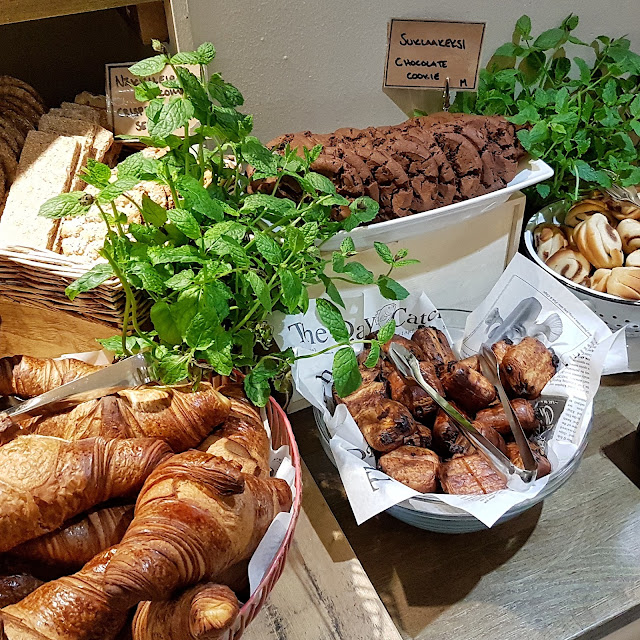



































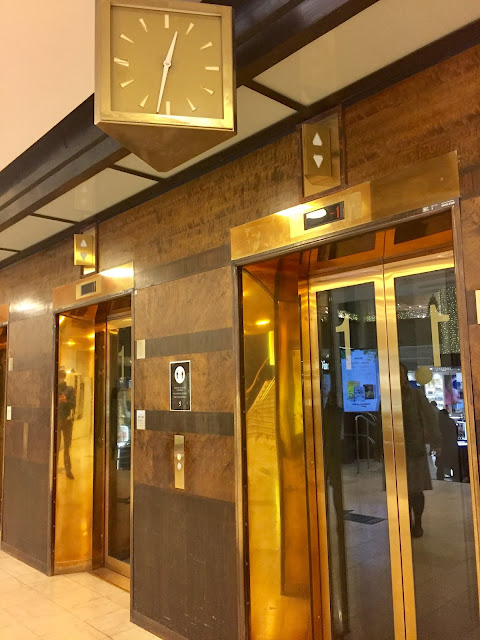















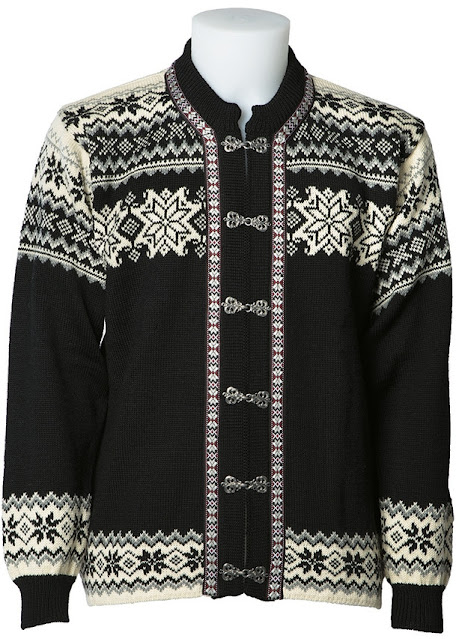








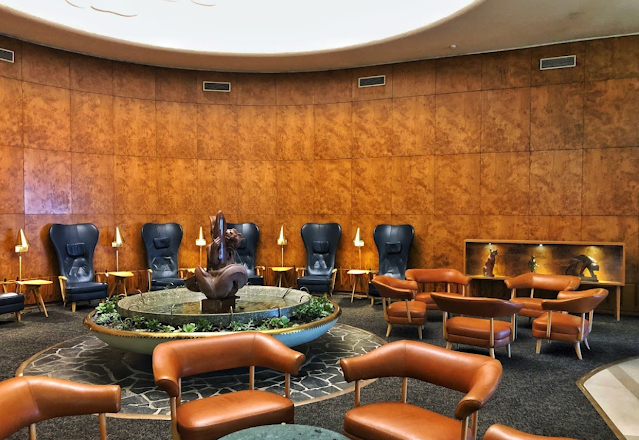











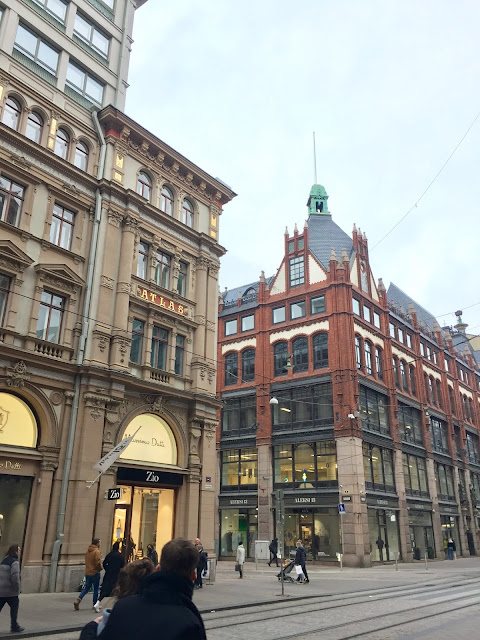

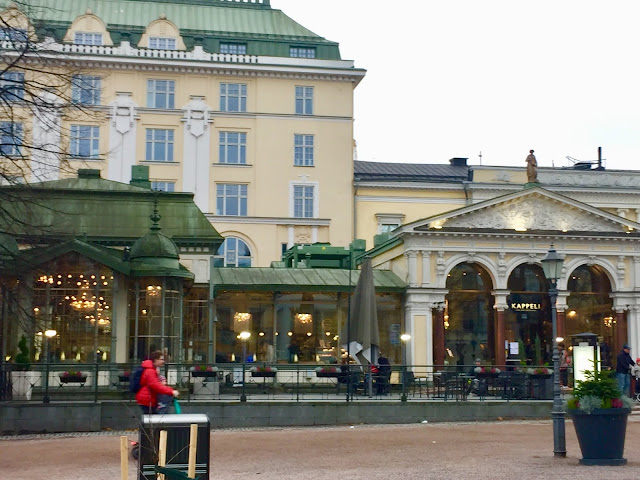






















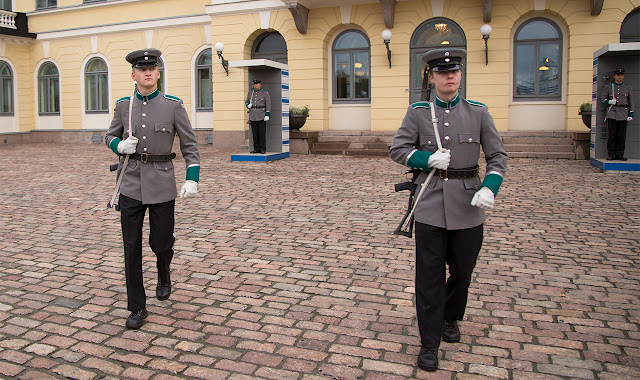



















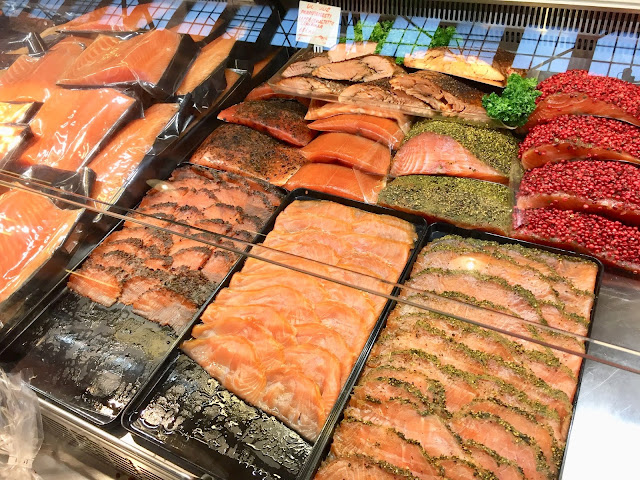
















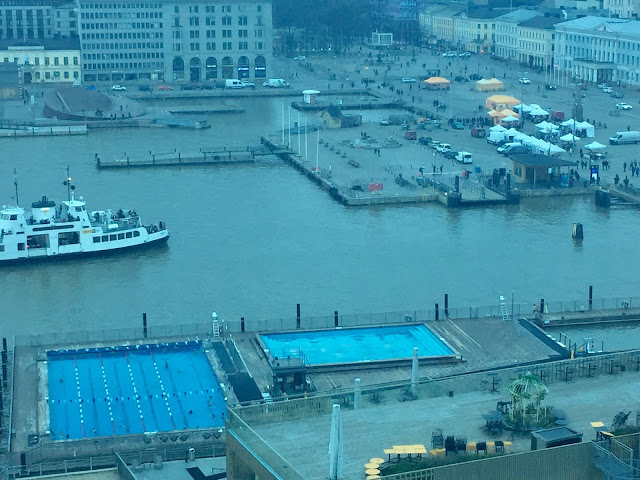






























No comments:
Post a Comment
Don't be shy: leave your comments :)